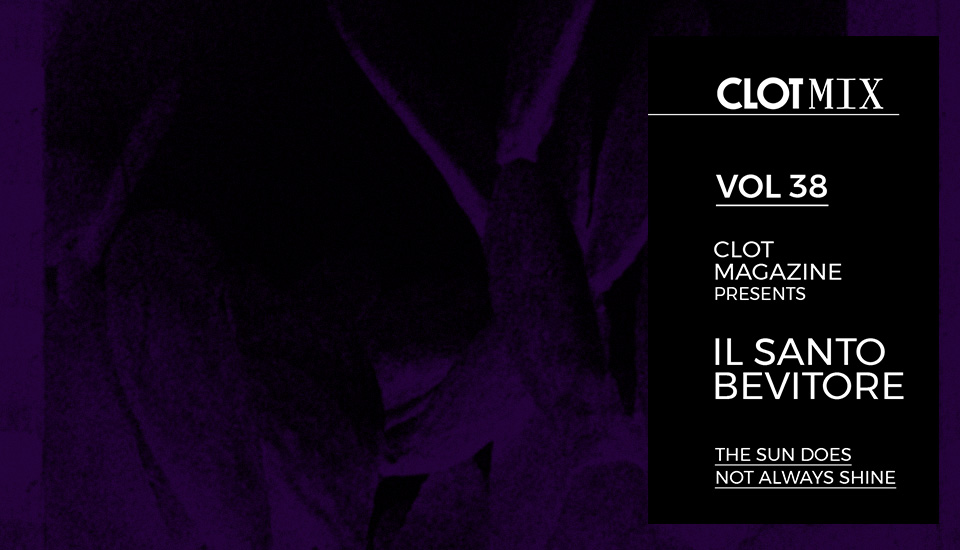Text by Agata Kik

Il Santo Bevitore is the artistic alter ego of the Italian-born London-based musician, producer and sound engineer Nicola Serra, who is also known for being the founding curator of London’s experimental music festival Dronica. The following mixtape is shared on the occasion of his recent debut release for Opal Tapes Water and Tears.
The mixtape includes tracks from my album and music from artists who inspired, either directly or indirectly, the album process”, shares Il Santo Bevitore.
To have worked on the album with 11 other musicians and artists, who contributed their vocals and various instruments, shows extraordinary determination to experiment with new ways of working on the recording process while still on unstable grounds during the past two years of the pandemic. The sound on the album is heavily processed thanks to that and, as a result, creates an extensive depth of soundscapes, which immerse the listener into the voyage under the artist’s spell.
‘Water and Tears’ has been inspired by the painful story of the Panas, women lost during childbirth, and the Sardinian ancestral pagan past, its people and their echoes. Each track is characterised by thick sonic textures and comprises multiple layers of sound sources. Some of the voices I used belong to an ancestral Sardinian and Italian folkloric past, which is emphasised, brought back to life, and projected into the future thanks to technology.
Keen on continuing his explorations of compositions of inseparably intertwined analogue instruments and digital technology while embracing his curatorial practice, Il Santo Bevitore is now looking forward to more collaborations and working with other artists in the near future.
What was the creative process like for the production of your new album? What were you sonically and conceptually exploring with it?
During the making of this new album, I extensively worked on the sonic textures, the use of vocals and the variety of instruments and sources used. In each track, there are many layers of sounds to create dense and thick textures that would also feel spacious at the same time. The sound was heavily processed and reprocessed several times.
Often using the audio shrink as a key for composition and sound design, I was seeking a sound as powerful and intense as it could possibly be. Samples that I thought could fit well with the whole concept of the album, were meticulously selected and archived, as well as field recordings that were recorded in the past few years at different times and locations. Conceptually speaking, the whole album has been deeply and mainly inspired by the painful story of the Panas, women lost via childbirth, and the Sardinian ancestral pagan past, its people and their echos.
Water and Tears includes multiple instrumental collaborations and a multitude of sounds belonging to many different soundscapes. What were the main challenges for this production developed over the 24 months of the pandemic?
Although I believe creativity can be a way to escape stress, often it just takes a huge effort to get past whatever stressful situation someone is going through. Certainly, the pandemic was one of those situations. While trying to keep focused and staying positive and inspired, stress was one of the biggest challenges during the album’s production. Collaborating with fellow artists was a great way of reconnecting with other human beings, as well as a way to embrace my curatorial work, by involving other producers and musicians.
What are your main inspirations for your productions these days and towards which direction do you see your interests develop after this release?
Sonically speaking, I’d like to keep exploring the endless possibilities and combinations between analogue gear and technology. Everything really. Collaborating with other artists is definitely something I would also like to continue and develop after this release, hopefully widening up the spectrum of my influences and inspirations and pushing boundaries by collaborating with many different artists.
What is your relationship with technology and the analogue, how do you combine instruments and voices in your practice?
I used to have a love-hate relationship with technology, but now I can see technology and the analogue as a whole. Some of the voices I used belong to an ancestral Sardinian and Italian folkloric past, which is emphasized and brought back to life and projected into the future thanks to technology. Others were performed by the amazing Cerpintxt and Urban Feral. As a result of being a drummer in several bands when I was younger acoustic instruments, and musicians will always play a fundamental part in my work.






